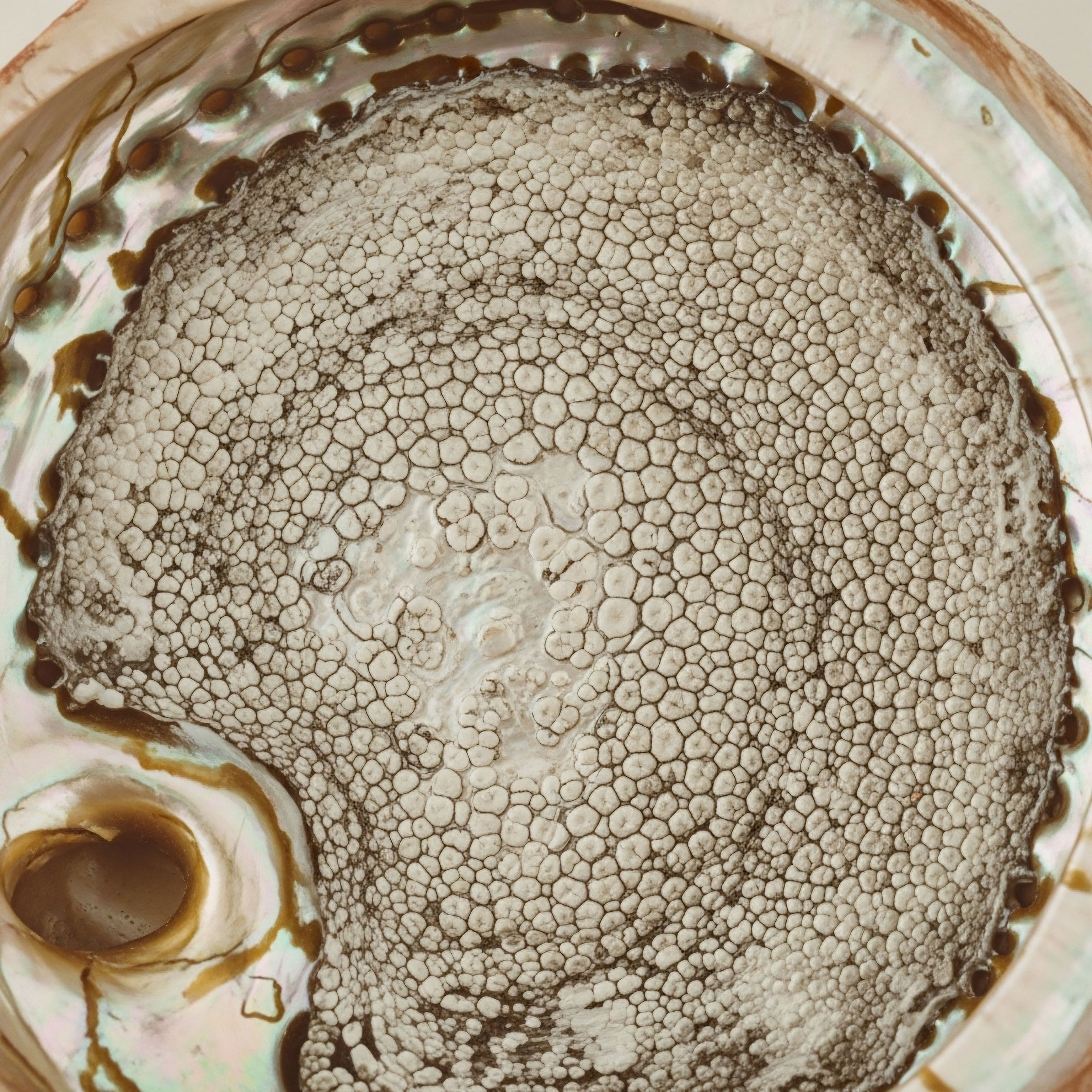

Fundamentals
The subtle shifts within our physiological landscape often begin imperceptibly, manifesting as a persistent fatigue, a recalcitrant weight gain, or a pervasive sense of disquiet that defies easy explanation. Many individuals experience these systemic dysregulations, diligently pursuing various lifestyle adjustments yet finding themselves still adrift from their desired state of vitality.
This lived experience, a profound disconnect between effort and outcome, forms the starting point for understanding how our internal biological symphony can fall out of tune. Reclaiming robust health requires a deeper appreciation of the body’s intrinsic communication networks, particularly the endocrine system, which orchestrates a vast array of vital functions.
Consider the endocrine system as the body’s internal messaging service, a complex network of glands secreting hormones ∞ these biochemical emissaries ∞ into the bloodstream to regulate metabolism, growth, mood, and reproductive function. This intricate communication ensures every cell and organ receives its precise instructions, maintaining a delicate equilibrium essential for overall well-being.
Lifestyle factors, encompassing nutritional choices, movement patterns, restorative sleep, and mental equilibrium, act as the primary conductors of this biological orchestra. When these foundational elements are optimized, the body often responds with remarkable resilience, fostering a state of hormonal harmony.
Our body’s internal communication network, the endocrine system, relies on hormones to orchestrate vital functions, and lifestyle factors serve as the primary conductors of this intricate biological symphony.

Understanding Hormonal Communication
Hormones operate through a sophisticated feedback loop mechanism, much like a finely tuned thermostat system. When levels of a particular hormone dip below a set point, the endocrine glands receive signals to increase production. Conversely, when concentrations rise too high, signals prompt a reduction in synthesis.
This constant calibration ensures the body adapts to internal and external demands, maintaining homeostasis. Disruptions to this delicate balance can precipitate a cascade of symptoms, ranging from subtle shifts in energy to more pronounced metabolic and reproductive challenges.

The Role of Lifestyle as a Biological Modulator
Every choice we make, from the foods we consume to the quality of our sleep, directly influences the endocrine system’s ability to maintain its equilibrium. A diet rich in micronutrients and healthy fats provides the necessary building blocks for hormone synthesis, while consistent physical activity enhances cellular sensitivity to these chemical messengers.
Conversely, chronic stress can dysregulate cortisol rhythms, impacting other hormonal axes, and inadequate sleep impairs the restorative processes crucial for endocrine gland function. These lifestyle elements, therefore, establish the foundational environment within which all other therapeutic interventions operate.
Within this sophisticated biological framework, targeted peptide therapies emerge as precise biochemical modulators. Peptides, short chains of amino acids, function as endogenous signaling molecules, naturally present in the body to guide cellular behavior. These molecular messengers possess the capacity to fine-tune existing physiological pathways, offering a refined means to support and amplify the benefits derived from an optimized lifestyle.
They work with the body’s innate intelligence, guiding cells toward more efficient and balanced function, rather than overriding natural processes.


Intermediate
For individuals already familiar with the foundational principles of endocrine health, the natural progression involves understanding the precise interplay between lifestyle and specific hormonal axes, alongside the judicious application of targeted peptide therapies. Optimized lifestyle choices serve as potent regulators of our internal chemistry, directly influencing the efficacy of our hormonal communication systems. When these elements are in place, specific peptides can act as sophisticated co-regulators, guiding the body toward a more robust and resilient endocrine state.
Lifestyle elements exert a profound, direct impact on critical hormonal pathways. For instance, consistent physical activity improves insulin sensitivity, facilitating glucose uptake by cells and mitigating the risk of metabolic dysregulation. Adequate, high-quality sleep restores the natural pulsatile release of growth hormone and optimizes cortisol’s diurnal rhythm, both essential for tissue repair and stress adaptation.
Nutrient-dense nutrition provides precursors for hormone synthesis and supports gut microbiome health, which in turn influences systemic inflammation and nutrient absorption, both crucial for endocrine function.
Targeted peptides, when integrated with an optimized lifestyle, function as precise biochemical modulators, enhancing the body’s natural capacity for hormonal balance and systemic vitality.

Targeted Peptide Protocols for Endocrine Support
Targeted peptide therapies offer a precise means to address specific endocrine needs, working in concert with a supportive lifestyle. These agents can stimulate endogenous hormone production, modulate receptor sensitivity, or facilitate tissue repair, offering a highly individualized approach to biochemical recalibration. The selection of a specific peptide depends upon the individual’s unique physiological profile and therapeutic objectives.

Growth Hormone Secretagogue Peptides
A significant category of peptides involves growth hormone secretagogues (GHSs), which stimulate the body’s natural production of growth hormone (GH). Growth hormone plays a central role in cellular regeneration, metabolic regulation, and body composition. As we age, natural GH production declines, contributing to changes in muscle mass, fat distribution, and overall vitality.
- Sermorelin ∞ A synthetic analog of growth hormone-releasing hormone (GHRH), Sermorelin stimulates the pituitary gland to release GH in a pulsatile, physiological manner. This approach avoids the supraphysiological spikes associated with exogenous GH administration, promoting balanced outcomes. Its benefits extend to improved sleep quality, enhanced body composition, and accelerated recovery.
- Ipamorelin and CJC-1295 ∞ Ipamorelin, a ghrelin mimetic, selectively stimulates GH release from the pituitary without significantly impacting cortisol or prolactin levels. When combined with CJC-1295 (a GHRH analog with a longer half-life), this pairing creates a sustained, synergistic release of GH, contributing to increased lean muscle mass, reduced adiposity, and improved cellular repair.
- Tesamorelin ∞ This GHRH analog specifically reduces visceral adipose tissue, a type of fat associated with metabolic dysfunction. Tesamorelin acts directly on the pituitary to increase GH release, demonstrating particular efficacy in improving body composition and metabolic markers, especially when lifestyle interventions alone prove insufficient.
- Hexarelin and MK-677 ∞ Hexarelin functions as a potent GHS, stimulating GH release and potentially supporting cardiovascular health and tissue regeneration. MK-677, an orally active non-peptide GHS, also increases GH and IGF-1 levels, promoting muscle growth, improved sleep, and skin health.

Hormonal Optimization Protocols
For individuals seeking comprehensive hormonal optimization, peptides can augment the efficacy of traditional hormonal support. In men, managing declining testosterone levels often involves precise protocols designed to restore physiological balance while preserving endogenous function.
Testosterone Replacement Therapy (TRT) for men typically involves weekly intramuscular injections of Testosterone Cypionate, aiming to restore serum testosterone to optimal physiological ranges. To mitigate potential testicular atrophy and preserve fertility, Gonadorelin, a gonadotropin-releasing hormone (GnRH) analog, can be administered via subcutaneous injections twice weekly.
Gonadorelin stimulates the pituitary to release luteinizing hormone (LH) and follicle-stimulating hormone (FSH), thereby maintaining testicular function. Anastrozole, an aromatase inhibitor, may be included twice weekly as an oral tablet to manage estradiol levels if testosterone conversion to estrogen becomes excessive, preventing associated side effects. Enclomiphene, a selective estrogen receptor modulator, offers an alternative strategy to support LH and FSH levels, thereby promoting natural testosterone production.
Women experiencing symptoms related to hormonal changes, such as irregular cycles, mood shifts, or reduced libido, also benefit from carefully calibrated protocols. Testosterone Cypionate, administered weekly via subcutaneous injection at low doses (typically 10 ∞ 20 units or 0.1 ∞ 0.2ml), can significantly improve vitality and sexual health. Progesterone prescription aligns with menopausal status, supporting uterine health and mood regulation.
Pellet therapy, offering a long-acting subcutaneous delivery of testosterone, provides consistent hormonal support over several months, with Anastrozole integrated when appropriate to manage estrogenic effects.

Specialized Peptide Applications
Beyond systemic hormonal balance, specific peptides address targeted physiological needs.
- PT-141 (Bremelanotide) ∞ This melanocortin receptor agonist acts on the central nervous system to address sexual health concerns. It stimulates neural pathways involved in sexual desire and arousal, offering a unique mechanism for improving libido and sexual function in both men and women.
- Pentadeca Arginate (PDA) ∞ PDA is a synthetic peptide known for its remarkable tissue repair, healing, and anti-inflammatory properties. It supports cellular regeneration, enhances angiogenesis (new blood vessel growth), and modulates inflammatory responses, proving beneficial for recovery from injury, gut barrier function, and overall tissue integrity.
These targeted therapies, when integrated within a comprehensive lifestyle framework, offer a sophisticated pathway to amplify health outcomes. They provide precise biochemical signals that reinforce the body’s inherent capacity for self-regulation, moving beyond symptomatic relief toward a more fundamental restoration of function.
| Peptide Class | Key Peptides | Primary Mechanism | Lifestyle Synergy |
|---|---|---|---|
| Growth Hormone Secretagogues | Sermorelin, Ipamorelin, CJC-1295, Tesamorelin, Hexarelin, MK-677 | Stimulates endogenous Growth Hormone release | Enhances muscle gain from exercise, optimizes fat loss from nutrition, improves sleep quality |
| Gonadal Axis Modulators | Gonadorelin, Enclomiphene | Supports natural testosterone production, preserves fertility | Maintains hormonal balance alongside TRT, supports reproductive health |
| Sexual Function Peptides | PT-141 | Activates central nervous system pathways for sexual desire | Complements stress reduction and relationship well-being for enhanced intimacy |
| Tissue Repair Peptides | Pentadeca Arginate (PDA) | Promotes cellular regeneration, reduces inflammation, supports healing | Accelerates recovery from physical activity, supports gut health through nutrition |


Academic
The precise modulation of endocrine function through targeted peptide therapies represents a sophisticated frontier in personalized wellness, particularly when considered within a systems-biology framework that acknowledges the profound influence of lifestyle. A deep exploration of this synergy necessitates a granular understanding of molecular mechanisms, receptor kinetics, and the intricate feedback loops governing neuroendocrine axes.
Our focus here delves into how these exogenous peptides, acting as highly specific ligands, can re-establish homeostatic equilibrium within a body already primed for optimal function through diligent lifestyle practices.
The hypothalamic-pituitary-gonadal (HPG) axis, the hypothalamic-pituitary-adrenal (HPA) axis, and the somatotropic axis (GH-IGF-1) represent critical pillars of endocrine regulation, each profoundly susceptible to both lifestyle inputs and targeted peptide interventions. Chronic psychological stress, for instance, precipitates sustained glucocorticoid elevation via the HPA axis, which can subsequently suppress gonadal steroidogenesis through central inhibition of GnRH pulsatility.
This physiological cross-talk underscores the necessity of a holistic approach, where lifestyle factors like mindfulness and adequate sleep mitigate HPA overactivity, creating a receptive environment for peptides to exert their restorative effects.
Targeted peptide therapies operate as precise biochemical ligands, modulating specific receptor pathways to restore homeostatic equilibrium within the complex neuroendocrine system.

How Do Peptides Recalibrate Endocrine Signaling?
Peptides, as exogenous agents, leverage the body’s endogenous signaling pathways. Growth hormone-releasing peptides (GHRPs), such as Ipamorelin and Hexarelin, function as agonists at the growth hormone secretagogue receptor (GHSR-1a), a G-protein coupled receptor primarily expressed in the anterior pituitary.
Activation of GHSR-1a triggers intracellular signaling cascades involving phospholipase C and inositol triphosphate, leading to an influx of calcium ions and subsequent exocytosis of growth hormone. This mechanism bypasses the somatostatin inhibitory pathway, ensuring a robust yet physiological release of GH.
Similarly, GHRH analogs like Sermorelin and Tesamorelin bind to the growth hormone-releasing hormone receptor (GHRHR) on somatotrophs, activating the adenylate cyclase/cAMP pathway, which also culminates in GH secretion. The pharmacokinetic differences, such as CJC-1295’s sustained action due to its Drug Affinity Complex (DAC) modification, influence dosing frequency and the resulting GH pulsatility profiles, necessitating careful clinical consideration.
In the context of male hormonal optimization, Gonadorelin, a synthetic decapeptide identical to endogenous GnRH, stimulates the pulsatile release of LH and FSH from the anterior pituitary. This action directly supports testicular Leydig cell function and spermatogenesis, mitigating the negative feedback on the HPG axis often observed with exogenous testosterone administration.
Anastrozole, a non-steroidal aromatase inhibitor, competitively binds to the aromatase enzyme, preventing the conversion of androgens to estrogens. This precise inhibition helps maintain an optimal testosterone-to-estradiol ratio, averting estrogenic side effects such as gynecomastia and fluid retention, which can compromise treatment adherence and outcomes.

Molecular Mechanisms of Action and Interconnected Pathways
The efficacy of PT-141, or Bremelanotide, illustrates a distinct neuroendocrine mechanism. As a melanocortin receptor agonist, PT-141 primarily targets MC3R and MC4R within the central nervous system, particularly in the hypothalamus and preoptic area. Activation of these receptors modulates dopaminergic and oxytocinergic pathways, which are integral to sexual arousal and desire.
This central action distinguishes PT-141 from peripheral vasodilators, offering a therapeutic avenue for psychogenic or neuroendocrine-mediated sexual dysfunction. The precise receptor specificity minimizes off-target effects, highlighting the potential for highly selective pharmacological interventions.
Pentadeca Arginate (PDA), a synthetic peptide structurally analogous to BPC-157, exerts its profound tissue-regenerative and anti-inflammatory effects through multiple pathways. PDA has been observed to promote angiogenesis, facilitating neovascularization in damaged tissues, which is crucial for nutrient and oxygen delivery during repair.
It also modulates the expression of various growth factors, including vascular endothelial growth factor (VEGF) and basic fibroblast growth factor (bFGF), accelerating cellular proliferation and extracellular matrix remodeling. Furthermore, PDA exhibits significant anti-inflammatory properties by influencing cytokine production and neutrophil migration, thereby reducing localized and systemic inflammatory burdens. Its ability to stabilize the gut barrier and promote mucosal healing underscores its broad applicability in conditions characterized by compromised tissue integrity and chronic inflammation.
| Peptide | Receptor Target | Intracellular Signaling | Physiological Outcome |
|---|---|---|---|
| Ipamorelin | GHSR-1a | Gq-coupled, PLC/IP3, Ca2+ mobilization | Pulsatile GH release, improved body composition, sleep architecture |
| Sermorelin | GHRHR | Gs-coupled, Adenylate Cyclase/cAMP | Physiological GH release, cellular regeneration, metabolic regulation |
| Gonadorelin | GnRHR | Gq-coupled, PLC/IP3, Ca2+ mobilization | LH/FSH release, testicular function, spermatogenesis |
| PT-141 | MC3R, MC4R | Modulates dopaminergic and oxytocinergic pathways | Enhanced central sexual desire and arousal |
| Pentadeca Arginate | (Diverse, growth factor modulation, angiogenesis) | VEGF, bFGF modulation, cytokine regulation | Accelerated tissue repair, anti-inflammatory effects, gut integrity |

How Do Lifestyle Interventions Influence Peptide Efficacy?
The true power of targeted peptide therapies emerges when synergistically combined with optimized lifestyle interventions. For example, consistent resistance training enhances muscle protein synthesis and upregulates androgen receptors, creating a more responsive anabolic environment for testosterone and growth hormone.
Simultaneously, a diet rich in essential amino acids provides the substrate for both endogenous peptide synthesis and the anabolic processes stimulated by GHSs. Chronic sleep deprivation, conversely, blunts GH pulsatility and elevates catabolic hormones, potentially diminishing the therapeutic impact of GHRPs. This intricate web of interactions demonstrates that lifestyle does not merely support peptide therapy; it fundamentally shapes the cellular and systemic landscape within which these precise biochemical signals operate.
The consideration of genetic polymorphisms, individual metabolic phenotypes, and the gut microbiome’s composition further refines the application of these protocols. Variations in receptor sensitivity or enzyme activity can influence a peptide’s efficacy, necessitating a truly personalized approach to dosing and selection. Understanding these complex interdependencies allows for a more profound and enduring recalibration of endocrine health, moving beyond superficial symptom management to a deep restoration of physiological function.

What Long-Term Data Exists on Combined Peptide and Lifestyle Protocols?
While individual peptide therapies and lifestyle interventions possess robust evidence bases, the longitudinal data specifically examining the synergistic effects of combined peptide and lifestyle protocols is an evolving area of research. Clinical trials often isolate interventions to ascertain specific efficacy, yet real-world application frequently involves integrated strategies.
Observational studies and ongoing clinical experience suggest that patients adhering to comprehensive wellness plans, which include both targeted peptide support and optimized lifestyle factors, report sustained improvements in biomarkers and subjective well-being. Future research will likely involve more sophisticated designs, such as adaptive trials and real-world evidence studies, to precisely quantify the amplified benefits of these integrated approaches on markers of longevity, metabolic resilience, and endocrine health.

References
- Vance, Mary L. et al. “Growth Hormone-Releasing Hormone (GHRH) and its Analogs ∞ Clinical and Therapeutic Implications.” Journal of Clinical Endocrinology & Metabolism, vol. 84, no. 4, 1999, pp. 1177-1181.
- Bredella, Miriam A. et al. “Effects of Tesamorelin on Adiposity and Metabolic Parameters in HIV-Infected Patients with Lipodystrophy.” Annals of Internal Medicine, vol. 154, no. 6, 2011, pp. 379-389.
- Katznelson, Lawrence, et al. “Hypogonadism in Men ∞ An Endocrine Society Clinical Practice Guideline.” Journal of Clinical Endocrinology & Metabolism, vol. 99, no. 11, 2014, pp. 3927-3942.
- Davis, Susan R. et al. “Global Consensus Position Statement on the Use of Testosterone Therapy for Women.” Journal of Clinical Endocrinology & Metabolism, vol. 104, no. 10, 2019, pp. 4660-4666.
- Clayton, Peter E. et al. “The Growth Hormone Secretagogues ∞ Actions and Potential Clinical Applications.” Growth Hormone & IGF Research, vol. 19, no. 4, 2009, pp. 331-336.
- Palmisano, Beth T. and Anthony J. Di Cristofano. “Bremelanotide for Hypoactive Sexual Desire Disorder in Premenopausal Women.” Clinical Therapeutics, vol. 40, no. 10, 2018, pp. 1730-1738.
- Glaser, Rebecca. “Testosterone and Anastrozole Pellets for Menopausal Symptoms in Breast Cancer Survivors.” ASCO Breast Cancer Symposium Proceedings, 2014.
- Boron, Walter F. and Emile L. Boulpaep. Medical Physiology. 3rd ed. Elsevier, 2017.
- Guyton, Arthur C. and John E. Hall. Textbook of Medical Physiology. 13th ed. Elsevier, 2016.
- Schwarz, Stephan, et al. “The Impact of Lifestyle on Endocrine Health ∞ A Review.” Endocrine Reviews, vol. 42, no. 3, 2021, pp. 345-367.

Reflection
The journey toward understanding one’s own biological systems represents a profound act of self-discovery. As you have explored the intricate dance between lifestyle and endocrine health, amplified by the precision of targeted peptide therapies, consider this knowledge a foundational element. Your unique physiological narrative, expressed through symptoms and aspirations, guides the path forward.
The insights gained here serve as an invitation to engage with your health proactively, recognizing that a truly personalized path toward reclaimed vitality demands guidance tailored to your individual biochemical blueprint. This understanding empowers you to step into a future of sustained function and profound well-being.



